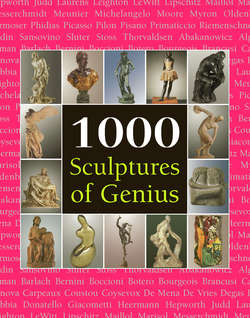1000 Scupltures of Genius

Реклама. ООО «ЛитРес», ИНН: 7719571260.
Оглавление
Patrick Bade. 1000 Scupltures of Genius
Introduction
The Classical World
The Collapse of Rome and the Rise of Medieval Culture
Renaissance and Baroque Europe: Naturalism and the Revival of Antiquity
The Modern Age: From Neoclassicism to the Twentieth Century
Antiquity
Middle Ages
Renaissance
Baroque
Modern
Glossary
Biographies
Magdalena Abakanowicz
Alessandro Algardi
Carl Andre
Benedetto Antelami
Hans Arp
Egid Quirin Asam
César Baldaccini, called Cesar
Nanni di Banco
Ernst Barlach
Richmond Barthe
Frédéric-Auguste Bartholdi
Gian Lorenzo Bernini
Umberto Boccioni
Giovanni Bologna called Giambologna
Fernando Botero
Edmé Bouchardon
Louise Bourgeois
Constantin Brancusi
Michelangelo Buonarroti, called Michelangelo
Pol Bury
Melchiore Caffa
Jean-Jacques Caffieri
Alexander Calder
Callimachus
Alonzo Cano
Antonio Canova
Sir Anthony Caro
Jean-Baptiste Carpeaux
Benvenutto Cellini
Camille Claudel
Michel Colombe
Charles Henri Joseph Cordier
Nicolas and Guillaume Coustou
Charles-Antoine Coysevox
Honoré Daumier
Hilaire-Germain-Edgar Degas
Andrea della Robbia
Luca della Robbia
Donatello
Jean Dubuffet
Marcel Duchamp
Raymond Duchamp-Villon
François Duquesnoy
Gregor Erhart
Etienne Maurice Falconet
Armand Fernandez, called Arman
Naum Gabo
Lorenzo Ghiberti
Alberto Giacometti
François Girardon
Jean Goujon
Horatio Greenough
Dame Barbara Hepworth
Jean Antoine Houdon
Donald Judd
Juan de Juni
Katarzyna Kobro
Henri Laurens
Lord Frederick Leighton
Leochares
Sol Lewitt
Jacques Lipschitz
Lysippos
Stefano Maderno
Aristide Joseph-Bonaventura Maillol
Marisol
Gaspard and Balthazar Marsy
Juan Martines Montanes
Henri Matisse
Guido Mazzoni
Pedro de Mena
Franz Xavier Messerschmidt
Constantin Meunier
Claude Michel, called Clodion
George Minne
Francesco Mochi
Henry Moore
Hans Multscher
Myron
Bruce Naumann
Claes Oldenburg
Augustin Pajou
Eduardo Paolozzi
Giuseppe Penone
Phidias
Pablo Ruiz Picasso
Jean-Baptiste Pigalle
Germain Pilon
Andrea Plsano
Nicola Pisano
Polykleitos
Jean-Jacques Pradier (James Pradier)
Praxiteles
Antoine-Auguste Preault
Barthelemy Prieur
Francesco Primaticcio
Pierre Puget
Tilman Riemenschneider
Auguste Rodin
Pedro Roldan
Antonio Rossellino
Medardo Rosso
François Rude
Auguste Saint-Gaudens
Niki de Saint-Phalle
Johann Gottfried Schadow
Andreas Schluter
Skopas
Claus Sluter
David Smith
William Wetmore Story
Veit Stoss
Sophie Taeuber-Arp
Takis
Jean Tinguely
Andrea del Verrocchio
Adriaen de Vries
Ossip Zadkine
Chronology
Отрывок из книги
The ancient Greeks, at first an isolated and provincial people among many population groups in the Mediterranean basin, rose to cultural, military, and political prominence, but they stood on the shoulders of giants and learned from the traditions of other ancient Mediterranean and Near Eastern civilisations. In the sphere of the arts, the Egyptians, in particular, had already developed a culture of idealised, well-proportioned human figures, a narrative tradition in painting and relief sculpture, and temple architecture that incorporated the display of a variety of sculptural elements. Yet the Greeks, in altering the static forms of the Egyptians, sought to craft sculptural figures that expressed life, movement, and a more fundamental and humane sense of moral potential. This development is seen in its early phase in the growing naturalism and subtlety of facial expression in sculpture produced in the Archaic period of the seventh and sixth centuries B.C.E. greater freedom of invention appeared during that time in vase painting, but sculptors, restrained by the intractability of stone and by convention, lagged somewhat behind. Reflecting a philosophical search for the ideal, the sculptors aimed at achieving timeless beauty. Just as Greek philosophers considered the nature of the ideal republic, perfect justice, or the ideal Good itself, artists brought forth a host of perfected forms. In their subject matter, sculptors often favoured the naked, youthful male body, a reflection of the Greek penchant for athleticism and military prowess, and an indication of the fluid boundaries of their range of sexual appreciation. A widespread and important form was the kouros, a free-standing male figure often placed at tombs in honour of the deceased. Kore, female equivalents of the kouroi, were clothed, following the convention of the time, but equally focused on youth, charm, and ideal beauty.
During the fifth century B.C.E. a mood of great confidence developed among the Athenian people, spawned by their victory over the Persians in 490–479 B.C.E. and by continued Athenian leadership among the collected Greek city-states. Indeed, the Athenian leader Perikles, in his famous oration (431 B.C.E.) for soldiers fallen in the Peloponnesian War, affirmed the superiority of Athens in cultural affairs, stating that their dedication to citizenship, sacrifice, and intellect formed the moral core of Athenian greatness. This was a moment of revolution in artistic style. Ever more explicitly based on the ideals of the perfect body, sculptured figures expanded in movement and emotion, but always with a moderating balance of weight, proportion, and rhythm. Equally important was the sense of palpable reality; sculpture, rather than being made of unadorned marble or bronze, was often enhanced by details in other media to achieve, in restrained fashion, an extra degree of naturalism. In later eras, a belief in the “purity” of the art of the Greeks led critics to overlook these additions, but the Greeks themselves gave life to their figures by painting on the marble key parts such as lips or eyes; in bronze sculpture, the highest and most enduring form of artistic technique, one found such additions as glass eyes and silver eyelashes. Later Greeks and Greek colonists would make a specialty of coloured terracotta figurines. The realm of ancient Greek sculpture was a lively and at times colourful world.
.....
86. Anonymous. Apollo Sauroktonos, Hellenistic copy after a Greek original created during the 4th century B.C.E. by Praxiteles. Marble. Museo Pio Clementino, Vatican (Italy). Greek Antiquity.
87. Anonymous. Aphrodite of Knidos, copy after a Greek original created around 350 B.C.E. by Praxiteles. Marble. Museo Pio Clementino, Vatican (Italy). Greek Antiquity.
.....